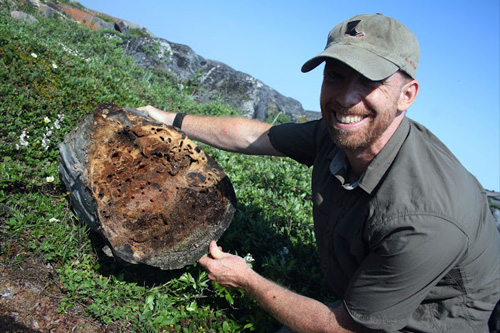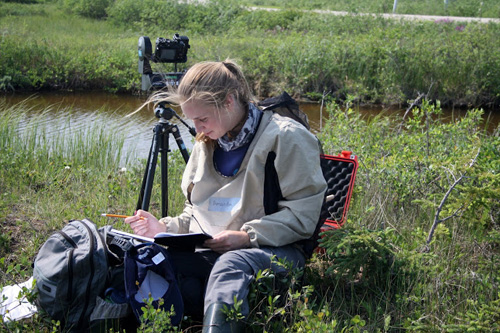
After their polar bear spotter shouted a warning, Kelsie Paris and her U of G classmates packed up and scrambled into the van. Only then did she realize that she’d left her digital camera out there on the tundra.
The camera contained all of her field trip photos, including shots she’d just snapped of the carnivore pacing along the Churchill intertidal flats some 500 metres away.
Later, she retrieved the camera intact. Back at the site the next day, the students discovered paw marks in the sand. “The prints were easily twice the size of my hand,” says the third-year ecology student.
That bear sighting was a high point for Paris and other University of Guelph students during a two-week field trip to Churchill, Man. – dubbed the world’s polar bear capital – in July 2012.
This month, those students and their instructors will share sights and impressions from U of G’s Arctic ecology field course in an online issue of GigaPan Magazine.
Their volume consists of eight high-resolution panoramic photographs showing the varied terrain and plant and animal life where the Churchill River empties into western Hudson Bay.
Last summer, pairs of students used GigaPan robot-controlled cameras to capture the landscape around the meeting place of boreal forest, Arctic tundra and Hudson Bay ecosystems.
Each day, the students programmed their robot-controlled cameras to take photos of the landscape. Hundreds of photos stitched together electronically yielded a 360-degree picture of each location. Online viewers can zoom in on sections of the panorama and read annotations about details from insects and spiders to carnivorous plants.
The technology gives students a new tool to document and share their field experiences, says Prof. Alex Smith, Integrative Biology. He and integrative biology professor Sarah Adamowicz led last year’s field trip.
Posted early this month, the online publication allows viewers anywhere in the world to zoom in and annotate the photos in turn. Those viewers might include other Guelph students using the photos as a virtual field trip to look at habitats and species without visiting Churchill, says Smith.
He says future field students visiting the same locations could use GigaPans to record changes over time, including potential effects of climate change on Arctic biodiversity.

With its mix of tundra ponds, fens, bogs, creeks, moraines and rock bluffs, says Smith, “Churchill is a very special place.”
He normally studies insects, particularly ants, in Costa Rica. During research trips there, he uses a GigaPan to record plants and animals.
What was it like in the subarctic at the beginning of July? “Cold, windy and rainy,” he says. But that was only the first day or so. After that, the sun came out, and the temperature rose to around 25C. “It was a ridiculously hot two weeks.”
No polar bears show up in the GigaPan shots, but the students found plenty of other organisms, from butterflies, dragonflies, ants, spiders and pond zooplankton to reindeer lichen, butterwort and bog rosemary.
“I didn’t expect so many insects,” says Cassie Russell, a third-year bioscience student. Sweeping the trees and bushes with a net turned up all kinds of creatures. She was fascinated by spiders especially. “I learned so much in two weeks.”
“It was the first time I ever saw a springtail,” says Kate Pare, a fourth-year wildlife biology student. She found all kinds of arthropods, including flies and wasps, around “tree islands” on the tundra. “I spent a lot of time lying on the ground.”
Besides recording the landscape with their cameras, the students collected organisms for DNA barcoding and species identification back at U of G’s Biodiversity Institute of Ontario.
They also had a chance to explore in other ways.
Paddling sea kayaks in the Churchill estuary brought them up close with pods of beluga whales.
Referring to the ghost-like shapes up to eight metres long gliding beneath the surface, Russell says, “They hit the bottom of your kayak. I was terrified at first.”
Adds third-year zoology student Hayley Cahill, “They have intelligent eyes, you think they’re examining you.”
Despite ice floes nearby in the river, some students donned heavy wetsuits to snorkel for 30-minute stretches. Dan Gibson spotted marine invertebrates, including ctenophores, or “comb jellies,” and jellyfish.
Comparing the experience to diving around Tobermory, Ont., he says, “It was super-cold.” The third-year zoology student will return to Churchill this summer as a research technician.
The Arctic field course takes place every two years. Begun in 1992, it has run in Churchill for more than a decade. Home base is the Churchill Northern Studies Centre, a research and teaching facility run since 1976.
Support for the student GigaPans came from the CREATE Lab Outreach Program at Carnegie Mellon University, U of G’s Learning Enhancement Fund, and the Fine Foundation, as well as the Natural Sciences and Engineering Research Council and the Canada Foundation for Innovation.
View all of the panoramic photographs from the field trip at http://www.gigapan.com/galleries/9086/gigapans.